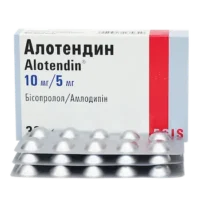Description
Arifam (Indapamide) Tablets with Modified Release 1.5 mg/5 mg. №30
Composition
Active ingredient: Indapamide. Other ingredients may include lactose, maize starch, hypromellose, and magnesium stearate.
Mechanism of Action
Pharmacological Properties: Indapamide promotes diuresis (increased urine production) and vasodilation (widening of blood vessels), leading to a reduction in blood pressure. It acts on the kidneys to increase the excretion of sodium and water, thus reducing the volume of circulating blood and lowering blood pressure.
Indications for Use
Indications: Arifam tablets are indicated for the treatment of hypertension (high blood pressure) and edema (fluid retention) associated with conditions such as congestive heart failure.
Contraindications
Contraindications: Do not use Arifam tablets if you are allergic to indapamide or any other ingredients in the formulation. It is contraindicated in patients with severe renal impairment, hepatic encephalopathy, and hypokalemia.
Side Effects
Side Effects: Common side effects may include dizziness, headache, electrolyte imbalances, and hypotension. Contact your healthcare provider if you experience any severe or persistent side effects.
Usage Instructions
Directions: Take Arifam tablets exactly as prescribed by your healthcare provider. Swallow the tablet whole with a glass of water. Do not crush or chew the tablet.
Benefits Compared to Analogues
Arifam tablets offer the advantage of a modified release formulation, providing sustained efficacy in the management of hypertension and edema compared to immediate-release formulations.
Suitable Patient Groups
Arifam tablets are suitable for adult patients with hypertension and edema. Dosage adjustments may be necessary for elderly patients or those with specific medical conditions. Consult your healthcare provider for personalized recommendations.
Storage and Shelf Life
Store Arifam tablets in a cool, dry place away from direct sunlight. Check the expiration date on the packaging and do not use the tablets beyond the stated shelf life.
Packaging Description
Arifam tablets are available in a package containing 30 tablets with a modified release of 1.5 mg/5 mg of indapamide. The packaging is designed to maintain the integrity and stability of the tablets.
Clinical Evidence and Proven Effectiveness
Scientific Evidence: Indapamide, the active ingredient in Arifam tablets, is a thiazide-like diuretic with proven efficacy in the management of hypertension. Studies have shown that indapamide effectively reduces blood pressure and helps in the management of edema associated with heart failure. Research published in the Journal of Hypertension has demonstrated the long-term benefits of using indapamide in reducing cardiovascular events.
Clinical Trials: Clinical trials have demonstrated the efficacy of indapamide in reducing cardiovascular events, including stroke and heart attacks, in patients with hypertension. A study published in the British Medical Journal showed a significant reduction in the incidence of stroke with the use of low-dose indapamide compared to a placebo.





